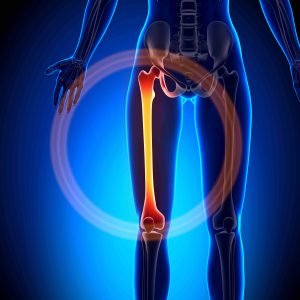Injuries of the femur
 The femur plays a vital role in everyday movement and function of the human body. Positioned proximal to the knee, people may also refer to the femur using the term thigh bone. Many muscles attach to the femur which allows for the body to move. Due to its vital role in the body, even a slight injury can debilitate. Typically when a bone plays such a vital role, that bone finds itself susceptible to injury. While bruising of the femur happens often, fractures of the femur do not happen that often. The femur has great strength which allows it to weight bear for the body and therefore does not easily fracture. When injuries of the femur occur, patients should seek evaluation from an orthopedic specialist.
The femur plays a vital role in everyday movement and function of the human body. Positioned proximal to the knee, people may also refer to the femur using the term thigh bone. Many muscles attach to the femur which allows for the body to move. Due to its vital role in the body, even a slight injury can debilitate. Typically when a bone plays such a vital role, that bone finds itself susceptible to injury. While bruising of the femur happens often, fractures of the femur do not happen that often. The femur has great strength which allows it to weight bear for the body and therefore does not easily fracture. When injuries of the femur occur, patients should seek evaluation from an orthopedic specialist.
Types of femoral injuries
Injuries to the femur may vary. Some injuries may cause great damage while physicians consider others quite minor. The affected area of the femur may also dictate whether or not the patient needs to seek medical attention. Injuries to the femur often occur during instances of high impact trauma. Instances of high impact trauma include falls, automobile accidents, and sporting events. Some individuals may have a higher risk of suffering from a femur injury than others. Age, weight, and activity level play a large role in a person’s likeliness to injure the femur. Common injuries to the femur include
- Bruises
- Strains
- Soft tissue injuries
- Fractures
- Hip fractures
- Stress Fractures
- Shaft fractures
Treating injuries to the femur
Patients should always go to an orthopedic specialist to have their femur treated. Treating femoral injuries depends on a variety of factors. The treatment of an injury to the femur may depend on the severity of the injury, the  location of the injury, and the type on injury. For simple injuries like bruising, a doctor may only prescribe rest, ice, and potentially non-steroidal anti-inflammatory medication. For serious injuries, a physician may need to put a cast on the leg of the patient or even perform a surgery to repair the femoral or hip fracture. The name hip fracture may sound misleading to some. When a fracture to the femoral neck occurs, physicians call it a hip fracture.
location of the injury, and the type on injury. For simple injuries like bruising, a doctor may only prescribe rest, ice, and potentially non-steroidal anti-inflammatory medication. For serious injuries, a physician may need to put a cast on the leg of the patient or even perform a surgery to repair the femoral or hip fracture. The name hip fracture may sound misleading to some. When a fracture to the femoral neck occurs, physicians call it a hip fracture.
To view a list of all insurances that AOA Orthopedic Specialists accept, click HERE. To schedule an appointment online, click HERE.
EXPERIENCING THIGH PAIN? CALL 817-375-5200 TO SCHEDULE AN APPOINTMENT WITH AN AOA ORTHOPEDIC SPECIALIST TODAY!
F.A.Q.
What are the symptoms of a femur injury?
Severe pain, swelling, bruising, discomfort, inability to bear weight on the leg, apparent deformity or shortening of the limb, and reduced range of motion at the hip or knee are all common symptoms.
How are femur injuries diagnosed?
A physical examination, review of symptoms, and imaging tests such as X-rays, CT scans, or MRI scans are often used to make a diagnosis. These examinations aid in determining the location, kind, and severity of the fracture.
How long does it take for a femur injury to heal?
The healing time depends on the severity of the fracture, the method of therapy, and personal characteristics. Simple fractures may heal in a matter of weeks to months; however, more difficult fractures or surgical cases may have a longer recovery period.
What is the rehabilitation process after a femur injury?
Rehabilitation and physical therapy are critical after the initial healing phase for recovering strength, mobility, and function in the damaged leg. Under the supervision of a healthcare practitioner, this may include exercises to enhance muscle strength, range of motion, and balance.

